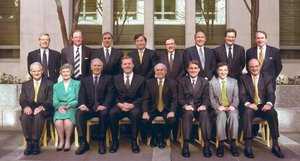Prime Minister of Australia
|
|
The office of Prime Minister is in practice the most powerful political office in the Commonwealth of Australia. The Prime Minister is head of government for the Commonwealth and holds office on commission from the Governor-General. Barring exceptional circumstances, the Prime Minister is always the leader of the political party with majority support in the House of Representatives. The Prime Minister's official residence is the Lodge in Canberra. Since 1996 the office-holder has been John Howard of the Liberal Party.
| Contents [hide] |
Appointment
The Prime Minister is appointed by the Governor-General under section 64 of the Australian Constitution. Section 64 of the Constitution empowers the Governor-General to appoint Ministers of State, and requires such Ministers to be members of the House of Representatives or the Senate. These Ministers are ex officio members of the Federal Executive Council and constitute the Cabinet. The Prime Minister in practice is the leader of the Cabinet. By convention, he or she will always be a Member of the House of Representatives.
The Prime Minister is, like other ministers, normally sworn in by the Governor General and then presented with the Commission (Letter patent) of office. When defeated in an election, or on resigning, the Prime Minister is said to "hand in the commission" and actually does so by returning it to the Governor General.
Despite the importance of the office of Prime Minister, the Constitution does not mention the office by name. The conventions of the Westminster system were thought to be sufficiently entrenched in Australia by the authors of the constitution that it was deemed unnecessary to detail them.
In rare circumstances, the Governor-General may appoint someone other than the leader of the majority party in the House of Representatives to be Prime Minister. At the time of Federation, no parliament had yet been established, so Edmund Barton was temporarily appointed as Prime Minister until elections were held. Following the death or resignation of the Prime Minister, the Governor-General will appoint as Prime Minister the person most likely to have majority support in the House of Representatives - in most circumstances, the Deputy Prime Minister. More controversially, during the 1975 constitutional crisis, Malcolm Fraser was appointed as caretaker Prime Minister to replace Gough Whitlam. Theoretically the Governor-General can dismiss the Prime Minister or any other Minister at any time, but his or her power to do so is heavily circumscribed by convention.
Powers
Most of the Prime Minister's powers derive from his or her position as the head of the Cabinet. In practice, the Federal Executive Council will act to ratify all decisions made by the Cabinet, and in practice, decisions of the Cabinet will always require the support of the Prime Minister. The powers of the Governor-General - to assent to legislation, to dissolve and prorogue Parliament, to call elections, and to make appointments - are exercised only on the advice of the Prime Minister.
The power of the Prime Minister is subject to a number of limitations. If the Prime Minister is removed as leader of his or her party, or if he or she loses a vote of no-confidence in the House of Representatives, he or she must resign the office or be dismissed by the Governor-General. The Prime Minister must receive the support of both houses of Parliament to pass any legislation (though secondary legislation, called Regulations, can be made by ministerial decree). While the Prime Minister normally will have a majority in the House of Representatives, attaining the support of the Senate can be more difficult, since there the Government will often be in a minority.
History
Ac.bartonministry.jpg
Since the framers of the Australian constitution from the beginning intended it to largely follow the Westminster system, the office of Prime Minister has existed since the inauguration of the Commonwealth.
List of Prime Ministers
Main article: List of Prime Ministers of Australia by important facts
The political parties shown are those to which the Prime Ministers belonged at the time they held office. Several Prime Ministers belonged during their life times to parties other than those of which they were members while occupying the office of Prime Minister.
See also
External links
- Australia's Prime Ministers (http://primeministers.naa.gov.au/) / National Archive of Australia
- Biographies of Australia's Prime Ministers (http://www.nma.gov.au/primeministers/contents.htm) / National Museum of Australia
- Official website of the Prime Minister of Australia (http://www.pm.gov.au/)
Template:AustraliaPMio:Prima ministri di Australia
id:Perdana Menteri Australia
zh:澳大利亚总理

